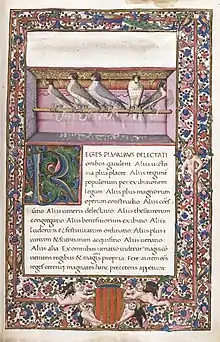
Moamyn (or Moamin) was the name given in Medieval Europe to an Arabic author of a five-chapter treatise on falconry, important for early Europeans, which was most popular as translated by the Syriac Theodore of Antioch[1] under the title De Scientia Venandi per Aves in 1240 to 1241. It also contained a chapter on hunting with dogs and chapters on other related subjects such as diseases of birds. There are about 27 Latin manuscript versions of Moamyn's work with two of them being illustrated throughout, with a well-known copy held in Vienna.
Identity
The true identity of Moamyn is a mystery. The name by which he was known in the medieval west is most likely the result of a corruption or simplification of the true pronunciation of the Arabic name. Based on this, among other reasons, François Viré has suggested that he is in fact Hunayn ibn Ishaq (809–873), physician of the Abbasid Caliphate. Thus, Moamyn would be the deformation of the original Arabic Hunayn.[2] However, there are other theories.
Origins
The Kitāb al-mutawakkilī of the mid ninth century was thought to be Moamyn's treatise on falconry in the original Arabic, but was discovered not to be in the 1980s. It was translated into Castilian in 1252 under the title Libro de los animales que caçan.[3][4]
Moamyn's work is largely based on the Kitāb al-ṭuyūr (كتاب الطيور), the Book of Birds (also known as the Kitāb dawari at-tayr, the Book of flight cycles(patterns) of Birds), a more extensive work by al-Ghiṭrīf ibn Qudāmah al-Ghassānī from the early ninth century.[5]
References
- ↑ Kedar, Benjamin Z; Kohlberg, Etan (2008). "The Intercultural Career of theodore of antioch". Mediterranean Historical Review. 10: 164–176. doi:10.1080/09518969508569690.
- ↑ Viré, François (1967). "Sur l'identité de Moamyn le fauconnier". Comptes Rendus des Séances de l'Académie des Inscriptions et Belles-Lettres. 111 (2): 172–176.
- ↑ Seniff, Dennis P. (1988). "Munchos libros buenos". Studia Neophilologica. 60 (2): 251–262. doi:10.1080/00393278808588006. ISSN 0039-3274.
- ↑ Enamorado, Virgilio Martínez (2011). "Falcons and Falconry in Al-Andalus". Studia Orientalia. 111: 159–184.
- ↑ Łukaszyk, Ewa (2011). "Mediterranean falconry as a cross-cultural bridge: Christian-Muslim hunting encounters". Birthday Beasts' Book: Cultural Studies in Honour of Jerzy Axer. Warsaw: Uniwersytet Warszawski, Instytut Badań Interdyscyplinarnych "Artes Liberales".